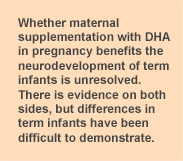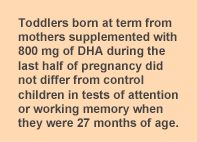
One of the most important reasons to assure the adequate intake of long-chain omega-3 PUFAs (n-3 LC-PUFAs) during pregnancy and early infancy is the importance of these fatty acids, especially DHA, in the structural and functional
development of the brain. Although DHA is found in cell membranes throughout the brain, it is especially concentrated in the hippocampus,
basal ganglia and frontal lobes, which are involved in cognition and executive functions. Animals and humans fed diets deficient in n-3 PUFAs during fetal and early postnatal life experience significantly
reduced content of DHA in their cerebral cortex and retina compared with those fed adequate n-3 PUFAs. Suboptimal dietary and brain DHA contents have been linked to
poorer performance on visual attention, cognitive and behavioral tests, although data are inconsistent, especially in term infants. Data from DHA-deficient animals have described various
behavioral and
cognitive deficits linked to lower DHA levels in the frontal cortex. In addition, n-3 PUFA-deficient animals display deficits in neuronal and
behavioral plasticity that carry over into adulthood. One of the challenges in evaluating cognitive and behavioral performance in humans is the selection of assessment measures. Tools that reflect
global cognitive function may be insufficiently sensitive for capturing specific brain and executive functions in young children. For this reason, measurement of attention is one aspect that has gained acceptance as a reflection of frontal lobe and hippocampus function and has been linked to
maternal DHA status. A recent report describes the effects of maternal n-3 LC-PUFA supplementation in pregnancy and the performance of executive functions in the 2-year-old offspring. Participants in this analysis were part of a larger randomized controlled trial, DHA for Maternal and Infant Outcomes. The investigators recruited 185 participants when the offspring turned 2 years of age, selecting from those who had not been born preterm, with low birthweight or neurologic or visual pathologies. Pregnant women were originally recruited into the study before 21 weeks’ gestation and had consumed 800 mg of DHA with 100 mg of EPA per day or a blended oil placebo from enrollment until delivery. A total of 158 children completed the assessments. They were 27 months of age, on average, at the time of testing.

The primary outcomes were the children’s looking times on measures of attention and the accuracy of locating a hidden figure on the working memory and inhibitory control assessment. Attention was evaluated using 3 tasks: single-object sustained attention, multiple object attention to one item and a distractibility task involving sustained attention to one object in the presences of a distracting stimulus. Each child’s responses were video recorded. To assess working memory and inhibitory control, the investigators used a lentil-box version of the A-not-B task described by
Spencer et al. and explained fully in the study publication. The results of all the attention tests showed no differences between the offspring of treatment and control mothers. The investigators noted that the latency for distraction increased across the distractibility trials, suggesting a learning effect. This observation did not differ between the groups. In the working memory assessment, the accuracy of finding the toy did not differ between the two groups. The investigators noted that control children were more accurate in searching for the hidden toy during training trials than treatment children, but this difference did not appear during test conditions.

This study found no evidence that DHA levels in cord plasma were associated with attention or working memory in 2-year-old children. The researchers observed some overlap of cord plasma DHA between the treated and control groups, but in separate analysis, the associations for some assessments occurred in both groups. Lack of consistent effects suggests that these observations may have been due to chance. Overall, the lack of any relationship between cord blood DHA levels and attention or memory outcomes agrees with
other findings, including from
this cohort, using global assessments of neurodevelopment. The investigators commented that even though cord plasma DHA levels in the supplemented mothers were higher than in the control women, term-born infants arrive with the full transfer of LC-PUFAs from the mother, which accelerates in the last trimester. Thus, the infants of both groups may have had sufficient DHA to provide for normal brain function. However, standard performance levels for the tests used have not been established. In well-nourished term infants, the provision of 800 mg of DHA per day in the last half of pregnancy was unrelated to the offspring’s performance on attention and working memory tests. Gould JF, Makrides M, Colombo J, Smithers LG. Randomized controlled trial of maternal omega-3 long-chain PUFA supplementation during pregnancy and early childhood development of attention, working memory, and inhibitory control.
Am J Clin Nutr 2014;99:851-859. [
PubMed] Open Access
Worth Noting Ramakrishnan U, Imhoff-Kunsch B, Martorell R. Maternal nutrition interventions to improve maternal, newborn and child health outcomes.
Nestle Nutr Inst Workshop Ser 20124;78:71-80. [
PubMed] Viljoen K, Vrijkotte TG, Wijga AH, Kogevinas M, Vrijheid M, Chatzi L. Fish intake during pregnancy, fetal growth, and gestational length in 19 European birth cohort studies.
Am J Clin Nutr 2014;99:506-516. [
PubMed] Open Access Loomans EM, Van den Bergh BR, Schelling M, Vrijkotte TG, van Eijsden M. Maternal long-chain polyunsaturated fatty acid status during early pregnancy and children’s risk of problem behavior at age 5-6 years.
J Pediatr 2014;164:762-768. [
PubMed] Jones ML, Mark PJ, Waddell BJ. Maternal dietary omega-3 fatty acids and placental function [Review].
Reproduction 2014;147:R143-R152. [
PubMed] Giorlandino C, Giannarelli D. Effect of vaginally administered DHA fatty acids on pregnancy outcome in high risk pregnancies for preterm delivery: a double blinded randomised controlled trial.
J Prenat Med 2013;7:42-45. [
PubMed] Open Access Kelsall CJ, Hoile SP, Irvine NA, Masoodi M, Torrens C, Lillycrop KA, Calder PC, Clough GF, Hanson MA, Burdge GC. Vascular dysfunction induced in offspring by maternal dietary fat involves altered arterial polyunsaturated fatty acid biosynthesis.
PLoS One 7:e34492. doi:10.1371/journal.pone.0034492. [
PubMed] Open Access
 One of the most important reasons to assure the adequate intake of long-chain omega-3 PUFAs (n-3 LC-PUFAs) during pregnancy and early infancy is the importance of these fatty acids, especially DHA, in the structural and functional development of the brain. Although DHA is found in cell membranes throughout the brain, it is especially concentrated in the hippocampus, basal ganglia and frontal lobes, which are involved in cognition and executive functions. Animals and humans fed diets deficient in n-3 PUFAs during fetal and early postnatal life experience significantly reduced content of DHA in their cerebral cortex and retina compared with those fed adequate n-3 PUFAs. Suboptimal dietary and brain DHA contents have been linked to poorer performance on visual attention, cognitive and behavioral tests, although data are inconsistent, especially in term infants. Data from DHA-deficient animals have described various behavioral and cognitive deficits linked to lower DHA levels in the frontal cortex. In addition, n-3 PUFA-deficient animals display deficits in neuronal and behavioral plasticity that carry over into adulthood. One of the challenges in evaluating cognitive and behavioral performance in humans is the selection of assessment measures. Tools that reflect global cognitive function may be insufficiently sensitive for capturing specific brain and executive functions in young children. For this reason, measurement of attention is one aspect that has gained acceptance as a reflection of frontal lobe and hippocampus function and has been linked to maternal DHA status. A recent report describes the effects of maternal n-3 LC-PUFA supplementation in pregnancy and the performance of executive functions in the 2-year-old offspring. Participants in this analysis were part of a larger randomized controlled trial, DHA for Maternal and Infant Outcomes. The investigators recruited 185 participants when the offspring turned 2 years of age, selecting from those who had not been born preterm, with low birthweight or neurologic or visual pathologies. Pregnant women were originally recruited into the study before 21 weeks’ gestation and had consumed 800 mg of DHA with 100 mg of EPA per day or a blended oil placebo from enrollment until delivery. A total of 158 children completed the assessments. They were 27 months of age, on average, at the time of testing.
One of the most important reasons to assure the adequate intake of long-chain omega-3 PUFAs (n-3 LC-PUFAs) during pregnancy and early infancy is the importance of these fatty acids, especially DHA, in the structural and functional development of the brain. Although DHA is found in cell membranes throughout the brain, it is especially concentrated in the hippocampus, basal ganglia and frontal lobes, which are involved in cognition and executive functions. Animals and humans fed diets deficient in n-3 PUFAs during fetal and early postnatal life experience significantly reduced content of DHA in their cerebral cortex and retina compared with those fed adequate n-3 PUFAs. Suboptimal dietary and brain DHA contents have been linked to poorer performance on visual attention, cognitive and behavioral tests, although data are inconsistent, especially in term infants. Data from DHA-deficient animals have described various behavioral and cognitive deficits linked to lower DHA levels in the frontal cortex. In addition, n-3 PUFA-deficient animals display deficits in neuronal and behavioral plasticity that carry over into adulthood. One of the challenges in evaluating cognitive and behavioral performance in humans is the selection of assessment measures. Tools that reflect global cognitive function may be insufficiently sensitive for capturing specific brain and executive functions in young children. For this reason, measurement of attention is one aspect that has gained acceptance as a reflection of frontal lobe and hippocampus function and has been linked to maternal DHA status. A recent report describes the effects of maternal n-3 LC-PUFA supplementation in pregnancy and the performance of executive functions in the 2-year-old offspring. Participants in this analysis were part of a larger randomized controlled trial, DHA for Maternal and Infant Outcomes. The investigators recruited 185 participants when the offspring turned 2 years of age, selecting from those who had not been born preterm, with low birthweight or neurologic or visual pathologies. Pregnant women were originally recruited into the study before 21 weeks’ gestation and had consumed 800 mg of DHA with 100 mg of EPA per day or a blended oil placebo from enrollment until delivery. A total of 158 children completed the assessments. They were 27 months of age, on average, at the time of testing.  The primary outcomes were the children’s looking times on measures of attention and the accuracy of locating a hidden figure on the working memory and inhibitory control assessment. Attention was evaluated using 3 tasks: single-object sustained attention, multiple object attention to one item and a distractibility task involving sustained attention to one object in the presences of a distracting stimulus. Each child’s responses were video recorded. To assess working memory and inhibitory control, the investigators used a lentil-box version of the A-not-B task described by Spencer et al. and explained fully in the study publication. The results of all the attention tests showed no differences between the offspring of treatment and control mothers. The investigators noted that the latency for distraction increased across the distractibility trials, suggesting a learning effect. This observation did not differ between the groups. In the working memory assessment, the accuracy of finding the toy did not differ between the two groups. The investigators noted that control children were more accurate in searching for the hidden toy during training trials than treatment children, but this difference did not appear during test conditions.
The primary outcomes were the children’s looking times on measures of attention and the accuracy of locating a hidden figure on the working memory and inhibitory control assessment. Attention was evaluated using 3 tasks: single-object sustained attention, multiple object attention to one item and a distractibility task involving sustained attention to one object in the presences of a distracting stimulus. Each child’s responses were video recorded. To assess working memory and inhibitory control, the investigators used a lentil-box version of the A-not-B task described by Spencer et al. and explained fully in the study publication. The results of all the attention tests showed no differences between the offspring of treatment and control mothers. The investigators noted that the latency for distraction increased across the distractibility trials, suggesting a learning effect. This observation did not differ between the groups. In the working memory assessment, the accuracy of finding the toy did not differ between the two groups. The investigators noted that control children were more accurate in searching for the hidden toy during training trials than treatment children, but this difference did not appear during test conditions.  This study found no evidence that DHA levels in cord plasma were associated with attention or working memory in 2-year-old children. The researchers observed some overlap of cord plasma DHA between the treated and control groups, but in separate analysis, the associations for some assessments occurred in both groups. Lack of consistent effects suggests that these observations may have been due to chance. Overall, the lack of any relationship between cord blood DHA levels and attention or memory outcomes agrees with other findings, including from this cohort, using global assessments of neurodevelopment. The investigators commented that even though cord plasma DHA levels in the supplemented mothers were higher than in the control women, term-born infants arrive with the full transfer of LC-PUFAs from the mother, which accelerates in the last trimester. Thus, the infants of both groups may have had sufficient DHA to provide for normal brain function. However, standard performance levels for the tests used have not been established. In well-nourished term infants, the provision of 800 mg of DHA per day in the last half of pregnancy was unrelated to the offspring’s performance on attention and working memory tests. Gould JF, Makrides M, Colombo J, Smithers LG. Randomized controlled trial of maternal omega-3 long-chain PUFA supplementation during pregnancy and early childhood development of attention, working memory, and inhibitory control. Am J Clin Nutr 2014;99:851-859. [PubMed] Open Access Worth Noting Ramakrishnan U, Imhoff-Kunsch B, Martorell R. Maternal nutrition interventions to improve maternal, newborn and child health outcomes. Nestle Nutr Inst Workshop Ser 20124;78:71-80. [PubMed] Viljoen K, Vrijkotte TG, Wijga AH, Kogevinas M, Vrijheid M, Chatzi L. Fish intake during pregnancy, fetal growth, and gestational length in 19 European birth cohort studies. Am J Clin Nutr 2014;99:506-516. [PubMed] Open Access Loomans EM, Van den Bergh BR, Schelling M, Vrijkotte TG, van Eijsden M. Maternal long-chain polyunsaturated fatty acid status during early pregnancy and children’s risk of problem behavior at age 5-6 years. J Pediatr 2014;164:762-768. [PubMed] Jones ML, Mark PJ, Waddell BJ. Maternal dietary omega-3 fatty acids and placental function [Review]. Reproduction 2014;147:R143-R152. [PubMed] Giorlandino C, Giannarelli D. Effect of vaginally administered DHA fatty acids on pregnancy outcome in high risk pregnancies for preterm delivery: a double blinded randomised controlled trial. J Prenat Med 2013;7:42-45. [PubMed] Open Access Kelsall CJ, Hoile SP, Irvine NA, Masoodi M, Torrens C, Lillycrop KA, Calder PC, Clough GF, Hanson MA, Burdge GC. Vascular dysfunction induced in offspring by maternal dietary fat involves altered arterial polyunsaturated fatty acid biosynthesis. PLoS One 7:e34492. doi:10.1371/journal.pone.0034492. [PubMed] Open Access
This study found no evidence that DHA levels in cord plasma were associated with attention or working memory in 2-year-old children. The researchers observed some overlap of cord plasma DHA between the treated and control groups, but in separate analysis, the associations for some assessments occurred in both groups. Lack of consistent effects suggests that these observations may have been due to chance. Overall, the lack of any relationship between cord blood DHA levels and attention or memory outcomes agrees with other findings, including from this cohort, using global assessments of neurodevelopment. The investigators commented that even though cord plasma DHA levels in the supplemented mothers were higher than in the control women, term-born infants arrive with the full transfer of LC-PUFAs from the mother, which accelerates in the last trimester. Thus, the infants of both groups may have had sufficient DHA to provide for normal brain function. However, standard performance levels for the tests used have not been established. In well-nourished term infants, the provision of 800 mg of DHA per day in the last half of pregnancy was unrelated to the offspring’s performance on attention and working memory tests. Gould JF, Makrides M, Colombo J, Smithers LG. Randomized controlled trial of maternal omega-3 long-chain PUFA supplementation during pregnancy and early childhood development of attention, working memory, and inhibitory control. Am J Clin Nutr 2014;99:851-859. [PubMed] Open Access Worth Noting Ramakrishnan U, Imhoff-Kunsch B, Martorell R. Maternal nutrition interventions to improve maternal, newborn and child health outcomes. Nestle Nutr Inst Workshop Ser 20124;78:71-80. [PubMed] Viljoen K, Vrijkotte TG, Wijga AH, Kogevinas M, Vrijheid M, Chatzi L. Fish intake during pregnancy, fetal growth, and gestational length in 19 European birth cohort studies. Am J Clin Nutr 2014;99:506-516. [PubMed] Open Access Loomans EM, Van den Bergh BR, Schelling M, Vrijkotte TG, van Eijsden M. Maternal long-chain polyunsaturated fatty acid status during early pregnancy and children’s risk of problem behavior at age 5-6 years. J Pediatr 2014;164:762-768. [PubMed] Jones ML, Mark PJ, Waddell BJ. Maternal dietary omega-3 fatty acids and placental function [Review]. Reproduction 2014;147:R143-R152. [PubMed] Giorlandino C, Giannarelli D. Effect of vaginally administered DHA fatty acids on pregnancy outcome in high risk pregnancies for preterm delivery: a double blinded randomised controlled trial. J Prenat Med 2013;7:42-45. [PubMed] Open Access Kelsall CJ, Hoile SP, Irvine NA, Masoodi M, Torrens C, Lillycrop KA, Calder PC, Clough GF, Hanson MA, Burdge GC. Vascular dysfunction induced in offspring by maternal dietary fat involves altered arterial polyunsaturated fatty acid biosynthesis. PLoS One 7:e34492. doi:10.1371/journal.pone.0034492. [PubMed] Open Access

